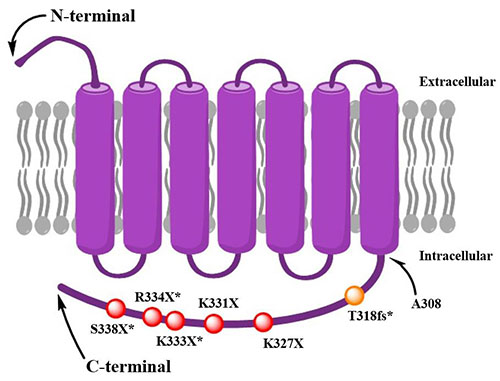
Contributions
Abstract: PB1935
Type: Publication Only
Background
Waldenstrom macroglobulinemia (WM) is a lymphoplasmacytoid lymphoma with IgM monoclonal gammopathy. Most of WM harbor MYD88 L265P and one thirds of WM with MYD88 present CXCR4 mutations. Currently, frequency of CXCR4 mutations and its clinical implication is not reported in Asian patients with WM.
Aims
We investigated the profiles of CXCR4 and MYD88 mutation in correlation with prognostic implication. To detect minor cell population with CXCR4 mutation, we adopted a ultra-deep sequencing strategy for CXCR4, which can detect specific variants <1% of the cell population.
Methods
Allele-specific PCR for MYD88 was performed on 37 patients with WM, along with 161 patients with B-cell neoplasms [diffuse large B-cell lymphoma (DLBCL), B-cell acute lymphoblastic leukemia (B-ALL), chronic lymphocytic leukemia (CLL)]. Deep-sequencing for CXCR4 and interphase fluorescent in situ hybridization (FISH) for 6q deletion was performed on 31 patients with WM. Clinicopathologic features were compared among 3 groups according to MYD88 and CXCR4 mutation status (Group 1, MYD88WT and CXCR4WT; group 2, MYD88L265 and CXCR4WT; group 3, MYD88L265P and CXCR4Mutation; statistical comparison, Fisher exact test, one-way ANOVA).
Results
MYD88 L265P mutation was detected in 81.3% (26/32) patients with WM, 10.8% (9/83) in patients with DLBCL, 9.5% (6/63) in patients with CLL, 0% (0/15) in patients with B-ALL, and 0% in 200 healthy persons. Among the 31 WM patients, 6 patients have CXCR4 mutation (19.4%) in the c-terminal domain (Figure 1); 1 frameshift mutation and 5 nonsense mutations. Two variants, K327X and K331X, are novel and the rest were known reported sites. All of them had MYD88 L265P mutation. FISH revealed 6q21 deletion in 14 patients (43.8%), and IGH rearrangement in 9 patients (28.1%). There was no correlation aming cytogenetic aberrations and genetic mutation (MYD88 and CXCR4). IgM levels of group 2 (MYD88L265 and CXCR4WT) were significantly higher than that of group 1 (MYD88WT and CXCR4WT) (P=0.024). Meanwhile, IgG level was significantly lower in group I, compared to group 3. Other clinical characteristics such as age, Hb, platelet, adenopathy, hyperviscosity showed no significant difference among 3 groups. Group I showed adverse survival and 1 year survival rate of group 1 (66.7%) was lower than group 2 (94.7%), though it was not statistically significant (P=0.410). There were no death events in group 3 (MYD88L265P and CXCR4Mutation) patients during the research period.

Conclusion
The frequency of CXCR4 mutation in Korean WM was similar to those of Caucasian. We suggest that ultra-deep sequencing using next generation sequencing can replace B cell sorting for the detection of CXCR4 mutation. Patients with MYD88WT and CXCR4WT showed higher IgM level and lower survival, suggesting an adverse prognostic implication. This is the first report on CXCR4 mutation in Korean WM patients.
Session topic: 13. Myeloma and other monoclonal gammopathies - Biology
Keyword(s): Waldenstrom's macroglobulinemia, CXCR4, Clinical data
Abstract: PB1935
Type: Publication Only
Background
Waldenstrom macroglobulinemia (WM) is a lymphoplasmacytoid lymphoma with IgM monoclonal gammopathy. Most of WM harbor MYD88 L265P and one thirds of WM with MYD88 present CXCR4 mutations. Currently, frequency of CXCR4 mutations and its clinical implication is not reported in Asian patients with WM.
Aims
We investigated the profiles of CXCR4 and MYD88 mutation in correlation with prognostic implication. To detect minor cell population with CXCR4 mutation, we adopted a ultra-deep sequencing strategy for CXCR4, which can detect specific variants <1% of the cell population.
Methods
Allele-specific PCR for MYD88 was performed on 37 patients with WM, along with 161 patients with B-cell neoplasms [diffuse large B-cell lymphoma (DLBCL), B-cell acute lymphoblastic leukemia (B-ALL), chronic lymphocytic leukemia (CLL)]. Deep-sequencing for CXCR4 and interphase fluorescent in situ hybridization (FISH) for 6q deletion was performed on 31 patients with WM. Clinicopathologic features were compared among 3 groups according to MYD88 and CXCR4 mutation status (Group 1, MYD88WT and CXCR4WT; group 2, MYD88L265 and CXCR4WT; group 3, MYD88L265P and CXCR4Mutation; statistical comparison, Fisher exact test, one-way ANOVA).
Results
MYD88 L265P mutation was detected in 81.3% (26/32) patients with WM, 10.8% (9/83) in patients with DLBCL, 9.5% (6/63) in patients with CLL, 0% (0/15) in patients with B-ALL, and 0% in 200 healthy persons. Among the 31 WM patients, 6 patients have CXCR4 mutation (19.4%) in the c-terminal domain (Figure 1); 1 frameshift mutation and 5 nonsense mutations. Two variants, K327X and K331X, are novel and the rest were known reported sites. All of them had MYD88 L265P mutation. FISH revealed 6q21 deletion in 14 patients (43.8%), and IGH rearrangement in 9 patients (28.1%). There was no correlation aming cytogenetic aberrations and genetic mutation (MYD88 and CXCR4). IgM levels of group 2 (MYD88L265 and CXCR4WT) were significantly higher than that of group 1 (MYD88WT and CXCR4WT) (P=0.024). Meanwhile, IgG level was significantly lower in group I, compared to group 3. Other clinical characteristics such as age, Hb, platelet, adenopathy, hyperviscosity showed no significant difference among 3 groups. Group I showed adverse survival and 1 year survival rate of group 1 (66.7%) was lower than group 2 (94.7%), though it was not statistically significant (P=0.410). There were no death events in group 3 (MYD88L265P and CXCR4Mutation) patients during the research period.

Conclusion
The frequency of CXCR4 mutation in Korean WM was similar to those of Caucasian. We suggest that ultra-deep sequencing using next generation sequencing can replace B cell sorting for the detection of CXCR4 mutation. Patients with MYD88WT and CXCR4WT showed higher IgM level and lower survival, suggesting an adverse prognostic implication. This is the first report on CXCR4 mutation in Korean WM patients.
Session topic: 13. Myeloma and other monoclonal gammopathies - Biology
Keyword(s): Waldenstrom's macroglobulinemia, CXCR4, Clinical data


